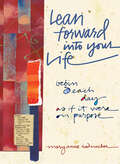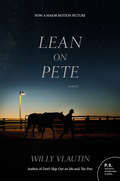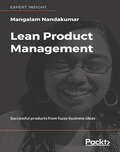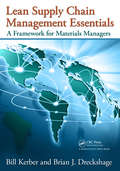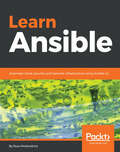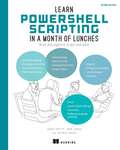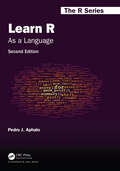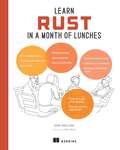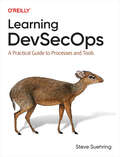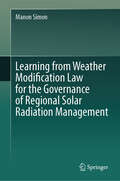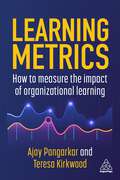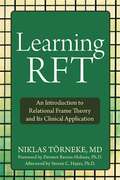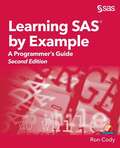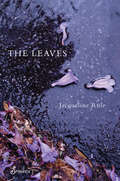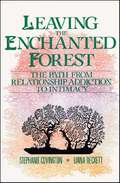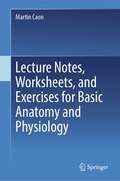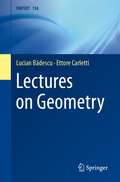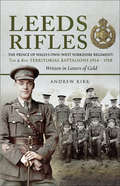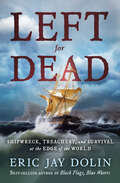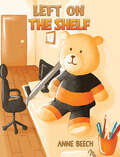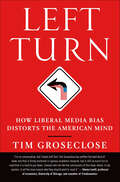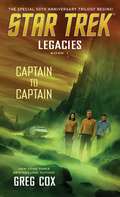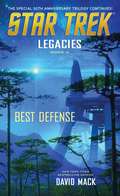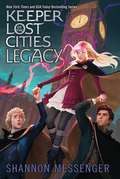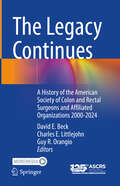- Table View
- List View
Lean Forward Into Your Life: Begin Each Day as If It Were on Purpose (Personal Development Ser.)
by Mary Anne RadmacherLead an Uncommon LifeWhat is your purpose in life? This is the question we ask ourselves far too often. In Lean Forward Into Your Life, author Mary Anne Radmacher invites you to find a new way to live: by leaning forward. When you’re trying to see something better, you lean toward it. When you are listening to someone and can barely hear, you lean in. When the really exciting part of a basketball game comes, you lean forward in your seat. When you’re trying to catch, to see, to listen to the best bits—you lean forward.Be intentional, always. This book does not fit in with typical self-help books. There are no quick and easy solutions, fool-proof steps to success, or thirty ways to hop, skip, and jump to a more successful, thinner, efficient, purposeful, happier life. Rather, this book is an invitation. A reflection. A mirror. A set of writing prompts to help you remember the questions you want to ask yourself for personal growth. An intimate portrait of some of the processes that have allowed Mary Anne Radmacher to live life how she chooses. And that can help you to live life how you choose too.Live a meaningful life of creative confidence and radical acceptance. This motivational book goes beyond finding your life goals. With the help of the incredible stories and thoughtful writing prompts in Lean Forward Into Your Life, you will learn how to:Begin each day as if it were on purposeListen hard, risk love, and play with abandonLive an uncommon life each and every dayReaders of personal development books and self-help books for women like Carry On, Warrior; Big Magic; or titles by Brené Brown, such as Daring Greatly and Rising Strong, will love Lean Forward Into Your Life.
Lean on Pete: A Novel
by Willy VlautinWilly Vlautin's award-winning novel follows the story of a newly orphaned fifteen-year old-boy struggling to make his way to a long lost aunt, who just might give him a home—now a major motion picture starring Chloë Sevigny (American Horror Story), Steve Buscemi (Boardwalk Empire) and Travis Fimmel (Warcraft) and directed by Andrew Haigh (45 Years, Looking).Fifteen-year-old Charley Thompson wants a home, food on the table, and a high school he can attend for more than part of a year. But as the son of a single father working in warehouses across the Pacific Northwest, Charley's been pretty much on his own. When tragic events leave him homeless weeks after their move to Portland, Oregon, Charley seeks refuge in the tack room of a run-down horse track. Charley's only comforts are his friendship with a failing racehorse named Lean on Pete and a photograph of his only known relative. In an increasingly desperate circumstance, Charley will head east, hoping to find his aunt who had once lived a thousand miles away in Wyoming—but the journey to find her will be a perilous one.In Lean on Pete, Willy Vlautin reveals the lives and choices of American youth like Charley Thompson who were failed by those meant to protect them and who were never allowed the chance to just be a kid.“The writing is spare and straightforward. . . . There is intensity in Vlautin’s narration, and also beauty and power . . . Vlautin’s major accomplishment lies in posing a damning question: How could we, as a society, have allowed this to happen?”— Seattle Times
Lean Product Management: Successful products from fuzzy business ideas
by Mangalam NandakumarA guide to product management exploring the best practices: identifying the impact-driven product, planning for success, setting up and measuring time-bound metrics, and developing a lean product roadmap.Key FeaturesIdentifying Impact-Driven ProductsInvesting in Key Business OutcomesValue mapping to maintain a lean product backlogUtilizing time-bound product metricsEliminating process wasteBook DescriptionLean Product Management is about finding the smartest way to build an Impact Driven Product that can deliver value to customers and meet business outcomes when operating under internal and external constraints. Author, Mangalam Nandakumar, is a product management expert, with over 17 years of experience in the field. Businesses today are competing to innovate. Cost is no longer the constraint, execution is. It is essential for any business to harness whatever competitive advantage they can, and it is absolutely vital to deliver the best customer experience possible. The opportunities for creating impact are there, but product managers have to improvise on their strategy every day in order to capitalize on them. This is the Agile battleground, where you need to stay Lean and be able to respond to abstract feedback from an ever shifting market. This is where Lean Product Management will help you thrive. Lean Product Management is an essential guide for product managers, and to anyone embarking on a new product development. Mangalam Nandakumar will help you to align your product strategy with business outcomes and customer impact. She introduces the concept of investing in Key Business Outcomes as part of the product strategy in order to provide an objective metric about which product idea and strategy to pursue. You will learn how to create impactful end-to-end product experiences by engaging stakeholders and reacting to external feedback. What you will learnHow do you execute ideas that matter?How can you define the right success metrics?How can you plan for product success?How do you capture qualitative and quantitative insights about the product? How do you know whether your product aligns to desired business goals?What processes are slowing you down?Who this book is forIf you are leading a team that is building a new product, then this book is for you. The book is targeted at product managers, functional leads in enterprises, business sponsors venturing into new product offerings, product development teams, and start-up founders.
Lean Supply Chain Management Essentials: A Framework for Materials Managers
by Bill Kerber Brian J. DreckshagePresenting an alternate approach to supply chain management, Lean Supply Chain Management Essentials: A Framework for Materials Managers explains why the traditional materials planning environment, typically embodied by an Enterprise Resource Planning (ERP) system, is an ineffective support system for a company that wants to adopt Lean practices.
Learn Ansible: Automate cloud, security, and network infrastructure using Ansible 2.x
by Russ McKendrickRun Ansible playbooks to launch complex multi-tier applications hosted in public cloudsKey FeaturesBuild your learning curve using AnsibleAutomate cloud, network, and security infrastructures with easeGain hands-on exposure on AnsibleBook DescriptionAnsible has grown from a small, open source orchestration tool to a full-blown orchestration and configuration management tool owned by Red Hat. Its powerful core modules cover a wide range of infrastructures, including on-premises systems and public clouds, operating systems, devices, and services—meaning it can be used to manage pretty much your entire end-to-end environment. Trends and surveys say that Ansible is the first choice of tool among system administrators as it is so easy to use.This end-to-end, practical guide will take you on a learning curve from beginner to pro. You'll start by installing and configuring the Ansible to perform various automation tasks. Then, we'll dive deep into the various facets of infrastructure, such as cloud, compute and network infrastructure along with security.By the end of this book, you'll have an end-to-end understanding of Ansible and how you can apply it to your own environments.What you will learnWrite your own playbooks to configure servers running CentOS, Ubuntu, and WindowsIdentify repeatable tasks and write playbooks to automate themDefine a highly available public cloud infrastructure in code, making it easy to distribute your infrastructure configurationDeploy and configure Ansible Tower and Ansible AWXLearn to use community contributed rolesUse Ansible in your day-to-day role and projectsWho this book is forLearn Ansible is perfect for system administrators and developers who want to take their current workflows and transform them into repeatable playbooks using Ansible. No prior knowledge of Ansible is required.
Learn PowerShell Scripting in a Month of Lunches, Second Edition: Write and organize scripts and tools (In a Month of Lunches)
by James Petty Don Jones Jeffery HicksAutomate complex tasks and processes with PowerShell scripts. This amazing book teaches you how to write, test, and organize high-quality, reusable scripts for Windows, Linux, and cloud-based systems.Learn PowerShell Scripting in a Month of Lunches, Second Edition takes you beyond command-line PowerShell and opens up the amazing world of scripting and automation. In just 27 bite-sized lessons, you&’ll learn to write scripts that can eliminate repetitive manual tasks, create custom reusable tools, and build effective pipelines and workflows. In Learn PowerShell Scripting in a Month of Lunches, Second Edition you&’ll learn: Setting up a reliable scripting environment Designing functions and scripts Effective pipeline usage Scripting and security Dealing with errors and bugs Source control with git Sharing and publishing scripts Professional-grade scripting practices The PowerShell language lets you write scripts to control nearly every aspect of Windows. Just master a few straightforward scripting skills, and you'll save yourself from hours of tedious tasks. This revised second edition is fully updated to PowerShell&’s latest version, including hands-on examples that perfectly demonstrate modern PowerShell&’s cross-platform applications. About the technology You can write PowerShell scripts to automate nearly any admin task on Windows, Linux, and macOS. This book shows you how! In just 27 short lessons you can complete on your lunch break, you&’ll learn to create, organize, test, and share scripts and tools that will save you hours of time in your daily work. About the book Learn PowerShell Scripting in a Month of Lunches, Second Edition is a hands-on introduction to PowerShell automation and toolbuilding. Updated for the latest version of PowerShell, this thoroughly revised bestseller teaches you how to write efficient scripts, find and squash bugs, and organize your tools into libraries. Along the way, you&’ll even pick up tips for securing and managing Linux and macOS systems. What's inside Setting up a reliable scripting environment Designing functions and scripts Effective pipeline usage Sharing and publishing scripts About the reader Beginning to intermediate knowledge of PowerShell required. About the author James Petty is CEO of PowerShell.org and The DevOps Collective and a Microsoft MVP. Don Jones and Jeffery Hicks are the authors of the first edition of Learn PowerShell Scripting in a Month of Lunches. Table of Contents PART 1 1 Before you begin 2 Setting up your scripting environment 3 WWPD: What would PowerShell do? 4 Review: Parameter binding and the PowerShell pipeline 5 Scripting language: A crash course 6 The many forms of scripting (and which to choose) 7 Scripts and security PART 2 8 Always design first 9 Avoiding bugs: Start with a command 10 Building a basic function and script module 11 Getting started with advanced functions 12 Objects: The best kind of output 13 Using all the streams 14 Simple help: Making a comment 15 Errors and how to deal with them 16 Filling out a manifest PART 3 17 Changing your brain when it comes to scripting 18 Professional-grade scripting 19 An introduction to source control with Git 20 Pestering your script 21 Signing your script 22 Publishing your script PART 4 23 Squashing bugs 24 Enhancing script output presentation 25 Wrapping up the .NET Framework 26 Storing data—not in Excel! 27 Never the end
Learn R: As a Language (Chapman & Hall/CRC The R Series)
by Pedro J. AphaloLearning a computer language like R can be either frustrating, fun or boring. Having fun requires challenges that wake up the learner’s curiosity but also provide an emotional reward for overcoming them. The book is designed so that it includes smaller and bigger challenges, in what I call playgrounds, in the hope that all readers will enjoy their path to R fluency. Fluency in the use of a language is a skill that is acquired through practice and exploration. For students and professionals in the biological sciences, humanities and many applied fields, recognizing the parallels between R and natural languages should help them feel at home with R. The approach I use is similar to that of a travel guide, encouraging exploration and describing the available alternatives and how to reach them. The intention is to guide the reader through the R landscape of 2024 and beyond.What is new in the second edition? Text expanded by more than 25% to include additional R features and gentler and more detailed explanations Contains 24 new diagrams and flowcharts, seven new tables, and revised text and code examples for clarity All three indexes were expanded, and answers to 28 frequently asked questions added What will you find in this book? Programming concepts explained as they apply to current R Emphasis on the role of abstractions in programming Few prescriptive rules—mostly the author’s preferences together with alternatives Presentation of the R language emphasizing the “R way of doing things” Tutoring for “programming in the small” using scripts for data analysis Explanation of the differences between R proper and extensions for data wrangling The grammar of graphics is described as a language for the construction of data visualisations Examples of data exchange between R and the foreign world using common file formats Coaching to become an independent R user, capable of writing original scripts and solving future challenges
Learn Rust in a Month of Lunches (In a Month of Lunches)
by David MacLeodOne month. One hour a day. That&’s all it takes to start writing Rust code!Learn Rust in a Month of Lunches teaches you to write super fast and super safe Rust code through lessons you can fit in your lunch break. Crystal-clear explanations and focused, relevant examples make it accessible to anyone—even if you&’re learning Rust as your first programming language. By the time you&’re done reading Learn Rust in a Month of Lunches you&’ll be able to: Build real software in Rust Understand messages from the compiler and Clippy, Rust&’s coding coach Make informed decisions on the right types to use in any context Make sense of the Rust standard library and its commonly used items Use external Rust &“crates&” (libraries) for common tasks Comment and build documentation for your Rust code Work with crates that use async Rust Write simple declarative macros Explore test driven development in Rust Learn Rust in a Month of Lunches is full of 24 easy-to-digest lessons that ease you into real Rust programming. You&’ll learn essential Rust skills you can use for everything from system programming, to web applications, and games. By the time you&’re done learning, you&’ll know exactly what makes Rust unique—and be one of the thousands of developers who say it&’s their best loved language! About the technology Learn how to create fast powerful programs in Rust in just 24 short lessons! Rust gives you modern features like a top-notch compiler, a rich ecosystem of pre-built libraries, and the same low-level performance you get with a language like C, but without the awkward syntax, complex memory management, and code safety concerns. This book guides you step by step from your first line of code. About the book Learn Rust in a Month of Lunches breaks down the Rust language into concise hands-on lessons designed to be completed in an hour or less. The examples are fun and easy to follow, so you&’ll quickly progress from zero Rust knowledge to handling async and writing your own macros. You won&’t even need to install Rust—the book&’s code samples run in the browser-based Rust Playground. There&’s no easier way to get started! What's inside Build working Rust software Understand messages from the compiler and Clippy Use external Rust &“crates&” (libraries) for common tasks Explore test driven development in Rust About the reader No previous experience with Rust required. About the author Dave MacLeod was an educator, Korean-English translator, project controller, and copywriter before becoming a full-time Rust developer. The technical editor on this book was Jerry Kuch. Table of Contents 1 Some basics 2 Memory, variables, and ownership 3 More complex types 4 Building your own types 5 Generics, option, and result 6 More collections, more error handling 7 Traits: Making different types do the same thing 8 Iterators and closures 9 Iterators and closures again! 10 Lifetimes and interior mutability 11 Multiple threads and a lot more 12 More on closures, generics, and threads 13 Box and Rust documentation 14 Testing and building your code from tests 15 Default, the builder pattern, and Deref 16 Const, &“unsafe&” Rust, and external crates 17 Rust&’s most popular crates 18 Rust on your computer 19 More crates and async Rust 20 A tour of the standard library 21 Continuing the tour 22 Writing your own macros 23 Unfinished projects: Projects for you to finish 24 Unfinished projects, continued
Learning DevSecOps: A Practical Guide To Processes And Tools
by Steve SuehringHow do some organizations maintain 24-7 internet-scale operations? How can organizations integrate security while continuously deploying new features? How do organizations increase security within their DevOps processes?This practical guide helps you answer those questions and more. Author Steve Suehring provides unique content to help practitioners and leadership successfully implement DevOps and DevSecOps. Learning DevSecOps emphasizes prerequisites that lead to success through best practices and then takes you through some of the tools and software used by successful DevSecOps-enabled organizations.You'll learn how DevOps and DevSecOps can eliminate the walls that stand between development, operations, and security so that you can tackle the needs of other teams early in the development lifecycle.With this book, you will:Learn why DevSecOps is about culture and processes, with tools to support the processesUnderstand why DevSecOps practices are key elements to deploying software in a 24-7 environmentDeploy software using a DevSecOps toolchain and create scripts to assistIntegrate processes from other teams earlier in the software development lifecycleHelp team members learn the processes important for successful software development
Learning from Weather Modification Law for the Governance of Regional Solar Radiation Management
by Manon SimonThis book investigates the role of cloud seeding laws in governing regional solar radiation management (SRM) activities. It challenges the prevailing belief that cloud seeding laws are irrelevant to regional SRM governance and argues for their applicability. Through case studies in Australia, Canada, and the United States, the book highlights the need for legal frameworks that promote cross-scale interactions, stakeholder participation, flexible decision-making, and conflict resolution. It advocates for adopting adaptive governance principles to effectively manage the risks and uncertainties associated with regional SRM interventions. By filling a gap in the existing literature, this book offers valuable insights and recommendations for the governance of regional SRM, shedding light on the potential of cloud seeding laws to inform and shape SRM governance frameworks. It provides a comprehensive analysis of the legal and normative aspects, offering practical guidance for policymakers, researchers, and stakeholders involved in regional SRM initiatives.
Learning Metrics: How to Measure the Impact of Organizational Learning
by Ajay Pangarkar Teresa KirkwoodHow do I know if Learning and Development (L&D) initiatives are making a difference to employee and business performance? What should I measure and how do I take a data-driven approach?Learning Metrics is a practical book for L&D professionals which answers these questions and provides guidance for measuring and communicating the impact of L&D activity in the business. It covers how to measure participant engagement with learning, learning retention and changes in employee performance post-learning. There is also guidance on how to measure on-the-job behaviour change as a result of learning, as well as metrics for measuring the organizational impact of learning. This book also has essential guidance on how to use learning analytics to assess the return on investment (ROI) of learning and how to use these results to adopt a data-driven approach and map learning metrics to organizational KPIs. Learning Metrics also includes guidance on how to communicate the impact of the company's learning and development activity to all business stakeholders. Full of practical guidance, examples, advice and case studies from organizations including Pfizer, Goldman Sachs, HSBC, Merck and Hewlett Packard, this is essential reading for all L&D professionals needing to measure the impact of L&D activity in the business but not sure where to start.
Learning RFT: An Introduction to Relational Frame Theory and Its Clinical Application
by Niklas TörnekeRelational frame theory, or RFT, is the little-understood behavioral theory behind a recent development in modern psychology: the shift from the cognitive paradigm underpinning cognitive behavioral therapy to a new understanding of language and cognition. Learning RFT presents a basic yet comprehensive introduction to this fascinating theory, which forms the basis of acceptance and commitment therapy. The book also offers practical guidance for directly applying it in clinical work. In the book, author Niklas Törneke presents the building blocks of RFT: language as a particular kind of relating, derived stimulus relations, and transformation of stimulus functions. He then shows how these concepts are essential to understanding acceptance and commitment therapy and other therapeutic models. Learning RFT shows how to use experiential exercises and metaphors in psychological treatment and explains how they can help your clients. This book belongs on the bookshelves of psychologists, psychotherapists, students, and others seeking to deepen their understanding of psychological treatment from a behavioral perspective.
Learning SAS by Example: A Programmer's Guide
by Ron CodyLearn to program SAS by example! Learning SAS by Example: A Programmer’s Guide, Second Edition, teaches SAS programming from very basic concepts to more advanced topics. Because most programmers prefer examples rather than reference-type syntax, this book uses short examples to explain each topic. The second edition has brought this classic book on SAS programming up to the latest SAS version, with new chapters that cover topics such as PROC SGPLOT and Perl regular expressions. This book belongs on the shelf (or e-book reader) of anyone who programs in SAS, from those with little programming experience who want to learn SAS to intermediate and even advanced SAS programmers who want to learn new techniques or identify new ways to accomplish existing tasks. <P><P>In an instructive and conversational tone, author Ron Cody clearly explains each programming technique and then illustrates it with one or more real-life examples, followed by a detailed description of how the program works. The text is divided into four major sections: Getting Started, DATA Step Processing, Presenting and Summarizing Your Data, and Advanced Topics. Subjects addressed include
The Leaves
by Jacqueline RuleFaith and Evelyn are close friends, neighbours, and single mothers ofLuke and of Mitch – and both bear the scars of the trauma of colonisationand the Stolen Generations. When Faith dies unexpectedly, a chain ofevents unfolds that will forever alter the lives of those left behind.As Luke faces upheaval and is propelled into the volatility of the fostersystem, Evelyn desperately tries to save him from the unending spiralof cruelty, poverty and disconnection from kin into which he descends,while the spectre of incarceration looms.The Leaves is a bittersweet meditation on motherhood and loss, onthe power of female friendship and the role of the state in perpetuatingviolence.Through Luke' s journey and Evelyn' s own pursuit of justice, The Leavesraises larger questions about the brutality and futility of Australia' s youthdetention system, the entrenchment of disadvantage, and the failure toacknowledge the ongoing effects of historical crimes committed againstIndigenous people.Will there be justice for Luke? Or will he be another invisible casualtyof a broken system?
Leaving the Enchanted Forest: The Path from Relationship Addiction to Intimacy
by Stephanie S. Covington Liana BeckettAdvice and step-by-step guidelines for those seeking to recover from addictive relationships.
Lecture Notes, Worksheets, and Exercises for Basic Anatomy and Physiology
by Martin CaonThis volume contains twenty-six lectures on basic anatomy and physiology for first-year university students. Topics included are standard for anatomy and physiology courses, including cells and tissues, a brief review of chemistry, thermoregulation and homeostasis, the musculo-skeletal system, structure and function of blood vessels, respiration, the reproductive system, and more.Also included are sixteen worksheets with homework exercises that complement the lectures. Suggested answers to all the worksheets are also included at the end of the book.This is an ideal book for professors teaching basic anatomy and physiology courses as well as researchers, students, and professionals looking to brush up on the subject. The book complements the already published, Martin Caon (2020) “Examination Questions and Answers in Basic Anatomy and physiology: 2900 Multiple Choice Questions and 64 Essay Topics. 3rd Ed.” Springer ISBN 978-3-030-47313-6
Lectures on Geometry (UNITEXT #158)
by Lucian Bădescu Ettore CarlettiThis is an introductory textbook on geometry (affine, Euclidean and projective) suitable for any undergraduate or first-year graduate course in mathematics and physics. In particular, several parts of the first ten chapters can be used in a course of linear algebra, affine and Euclidean geometry by students of some branches of engineering and computer science. Chapter 11 may be useful as an elementary introduction to algebraic geometry for advanced undergraduate and graduate students of mathematics. Chapters 12 and 13 may be a part of a course on non-Euclidean geometry for mathematics students. Chapter 13 may be of some interest for students of theoretical physics (Galilean and Einstein’s general relativity). It provides full proofs and includes many examples and exercises. The covered topics include vector spaces and quadratic forms, affine and projective spaces over an arbitrary field; Euclidean spaces; some synthetic affine, Euclidean and projective geometry; affine and projective hyperquadrics with coefficients in an arbitrary field of characteristic different from 2; Bézout’s theorem for curves of P^2 (K), where K is a fixed algebraically closed field of arbitrary characteristic; and Cayley-Klein geometries.
Leeds Rifles: The Prince of Wales's Own (West Yorkshire Regiment) 7th and 8th Territorial Battalions 1914–1918: Written in Letters of Gold
by Andrew J. KirkThe first detailed chronicle, with photos included, of the four battalions of riflemen who left Leeds for the Western Front. The full wartime story of the &“Leeds Pals&” has never been told. This volume describes their volunteer origins and how they came to be woven into the social fabric of Leeds from where they drew their enduring esprit de corps, discipline, and resolve. It takes the reader on a journey across the Western Front of the Great War, contrasting the first line battalion&’s lot, to stand in the mud of Ypres and endure all without breaking, with the second line battalion&’s blooding at Bullecourt and transformation as part of an elite assault division that went on to occupy Germany. It is told, in part, by those who were there and experienced the fear, elation, and sadness of loss, and who took strength from their volunteer ethos and their common origins in Leeds. All the Leeds Rifles&’ main battles are described in detail as are the helter-skelter actions of the last one hundred days of mobile warfare and escalating casualties, when the defeated but still defiant German army found itself in full and final retreat. Follow the fortunes of these enfants de Yorkshire, these Leeds Lads, as they speak out from the pages of history with a very familiar accent.
Left for Dead: Shipwreck, Treachery, and Survival at the Edge of the World
by Eric Jay DolinThe true story of five castaways abandoned on the Falkland Islands during the War of 1812—a tale of treachery, shipwreck, isolation, and the desperate struggle for survival. In Left for Dead, Eric Jay Dolin—“one of today’s finest writers about ships and the sea” (American Heritage)—tells the true story of a wild and fateful encounter between an American sealing vessel, a shipwrecked British brig, and a British warship in the Falkland archipelago during the War of 1812. Fraught with misunderstandings and mistrust, the incident left three British sailors and two Americans, including the captain of the sealer, Charles H. Barnard, abandoned in the barren, windswept, and inhospitable Falklands for a year and a half. With deft narrative skill and unequaled knowledge of the very pith of the seafaring life, Dolin describes in vivid and harrowing detail the increasingly desperate existence of the castaways during their eighteen-month ordeal—an all-too-common fate in the Great Age of Sail. A tale of intriguing complexity, with surprising twists and turns throughout—involving greed, lying, bullying, a hostile takeover, stellar leadership, ingenuity, severe privation, endurance, banishment, the great value of a dog, the birth of a baby, a perilous thousand-mile open-ocean journey in a seventeen-foot boat, an improbable rescue mission, and legal battles over a dubious and disgraceful wartime prize—Left for Dead shows individuals in wartime under great duress acting both nobly and atrociously, and offers a unique perspective on a pivotal era in American maritime history.
Left on the Shelf
by Anne BeechSheringham is a much-loved teddy bear but after many years of providing love and companionship finds he is no longer needed. He is left on a shelf with only his memories for company. The birth of a baby in the family, however, means that he is needed again. Sheringham can finally come down off the shelf and become a treasured member of a family once more.
Left Turn: How Liberal Media Bias Distorts the American Mind
by Tim GrosecloseA leading political science professor provides scientific proof of media bias in this sure-to-be-controversial bookDr. Tim Groseclose, a professor of political science and economics at UCLA, has spent years constructing precise, quantitative measures of the slant of media outlets. He does this by measuring the political content of news, as a way to measure the PQ, or "political quotient" of voters and politicians. Among his conclusions are: (i) all mainstream media outlets have a liberal bias; and (ii) while some supposedly conservative outlets—such the Washington Times or Fox News' Special Report—do lean right, their conservative bias is less than the liberal bias of most mainstream outlets. Groseclose contends that the general leftward bias of the media has shifted the PQ of the average American by about 20 points, on a scale of 100, the difference between the current political views of the average American, and the political views of the average resident of Orange County, California or Salt Lake County, Utah. With Left Turn readers can easily calculate their own PQ—to decide for themselves if the bias exists. This timely, much-needed study brings fact to this often overheated debate.
Legacies: Captain To Captain (Star Trek: The Original Series)
by Greg CoxAn epic new trilogy begins—a tie-in for the milestone fiftieth anniversary of Star Trek: The Original Series—that stretches from the earliest voyages of the Starship Enterprise to Captain Kirk’s historic five-year-mission…and from one universe to another!Hidden aboard the U.S.S. Enterprise is a secret that has been passed from captain to captain, from Robert April to Christopher Pike to James T. Kirk. Now the return of the enigmatic woman once known as Number One has brought that secret to light, and Kirk and his crew must risk everything to finish a mission that began with April so many years ago… Nearly two decades earlier, April and his crew first visited the planet Usilde, where they found both tragedy and a thorny moral dilemma. Today, the legacy of that fateful occasion will compel Kirk to embark on a risky voyage back to that forbidden world—which is now deep in territory claimed by the Klingon Empire! ™, ®, & © 2016 CBS Studios, Inc. STAR TREK and related marks and logos are trademarks of CBS Studios, Inc. All Rights Reserved.
Legacies #2: Best Defense (Star Trek: The Original Series)
by David MackJust in time for the milestone 50th Anniversary of Star Trek: The Original Series, an epic new trilogy that stretches from the earliest voyages of the Starship Enterprise to Captain Kirk’s historic five-year-mission—and from one universe to another!A debt of honor: One brave woman ventures alone into a parallel universe to save her old shipmates, exiled there decades earlier by a mysterious device called the Transfer Key. She soon learns the alternate universe harbors not just an alien invasion force, but a secret that underpins its very existence. A mission of peace: A long-awaited Klingon-Federation peace conference convenes, led by Ambassador Sarek of Vulcan and Councillor Gorkon of Qo&’noS. But both sides have enemies who would prefer the two great powers remain at war—and who will do anything to make certain hate wins the day. An errand of justice: Captain Kirk and his crew seek the stolen Transfer Key that opens a door between universes, but their hunt is cut short by Ambassador Sarek&’s plea for help. The Enterprise crew soon becomes targets in a deadly crossfire—one whose outcome will decide the fate of two universes.
Legacy (Keeper of the Lost Cities #8)
by Shannon MessengerIllusions shatter—and Sophie and her friends face impossible choices—in this astonishing eighth book in the New York Times and USA TODAY bestselling Keeper of the Lost Cities series.Sophie Foster wants answers. But after a lifetime of lies, sometimes the truth is the most dangerous discovery. Even the smallest secret comes with terrifying new responsibilities. And Sophie&’s not the only one with blank spots in her past, or mysteries surrounding her family. She and her friends are part of something much bigger than they imagined—and their roles have already been chosen for them. Every clue drags them deeper into the conspiracy. Every memory forces them to question everything—especially one another. And the harder they fight, the more the lines blur between friend and enemy.
The Legacy Continues: A History of the American Society of Colon and Rectal Surgeons and Affiliated Organizations 2000-2024
by David E. Beck Charles E. Littlejohn Guy R. OrangioThe ASCRS Executive Council has authorized production of an updated historical text to commemorate the 125th Anniversary of the Society (2024), a sequel of sorts to From Mathews to the Millennium - A Century of Achievement: A History of the American Society of Colon and Rectal Surgeons 1899-1999. Featuring personal and professional contributions from experienced members of the ASCRS, The Legacy Continues highlights the achievements, advancements and accomplishments of the ASCRS and affiliated societies over last 25 years (2000-2024), including educational efforts and meetings, noteworthy publications, important advances in surgical practice, board administration, research activities, training programs, and surgical leadership. It is an interesting and thought-provoking text not only for ASCRS members but colorectal surgeons worldwide with an interest in the growth and expansion of the field.
